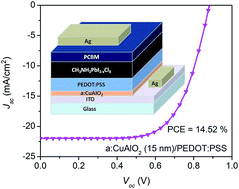A room-temperature CuAlO2 hole interfacial layer for efficient and stable planar perovskite solar cells†
Abstract
The fabrication and device parameters of inverted planar heterojunction (PHJ) organic–inorganic lead mixed-halide (CH3NH3PbI3−xClx) perovskite based solar cells (PSCs) using a:CuAlO2 as the hole selective buffer layer between the ITO electrode and PEDOT:PSS were demonstrated. Thin films of a:CuAlO2 were derived from a pre-fabricated polycrystalline CuAlO2 ceramic target by using the direct current (d.c.) magnetron sputtering technique. The one-step spin coating method was used to prepare the perovskite layer. A short circuit current density (Jsc) of 21.98 mA cm−2, an open circuit voltage (Voc) of 0.88 V, a fill factor (FF) of 0.75 and a power conversion efficiency (PCE) of 14.52% were achieved for the optimized device. These improved device parameters were also accompanied by improved stability as a result of sandwiching the ambient stable a:CuAlO2 layer with decent conductivity between the ITO and the PEDOT:PSS layers. The versatility of this material application was also demonstrated as a similar improvement in device performance and stability, which was observed by using the prepared a:CuAlO2 in another perovskite solar cell system based on CH3NH3PbI3 prepared by the two-step spin-coating method.


 Please wait while we load your content...
Please wait while we load your content...